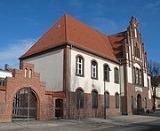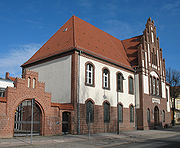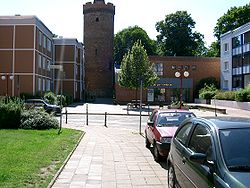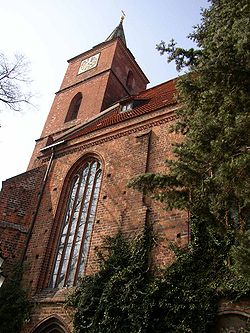
Bernau bei Berlin
Encyclopedia
Bernau bei Berlin is a German
town in the Barnim
district. The town is located about 10 km (6.2 mi) northeast of Berlin
.
prove the fact that this area has been inhabited since about 8800 BC.
The city was first mentioned in 1232. The true reasons of its founding are not known. According to a legend Albert I of Brandenburg
permitted the founding of the city in 1140 because of the good beer which was offered to him.
It is true that beer has been brewed with the water of the river Panke
. Therefore it was forbidden by law to pollute this river with waste and excrements before the days the brewing took place.
Bernau had its boom years before the Thirty Years' War
. Large parts of the defensive wall
with town gate and wet moats are relics of that time. These helped Bernau defend itself successfully against attackers, e.g. the Hussite
s in 1432. Following the plague and war Bernau was poor and bleak. Frederick I of Prussia
settled 25 Huguenot
ic families (craftsmen, farmers, traders and scientists) in 1699.
In 1842 a railway line was opened. One of the first electrical suburban railway lines in the world began operation in 1924. This line of the Berlin S-Bahn
connected Bernau with the Stettiner Bahnhof (today Berlin Nordbahnhof
) in Berlin. The Allgemeiner Deutscher Gewerkschaftsbund
(ADGB), a confederation of German trade unions, opened its school in 1930. The Waldsiedlung
(engl. residential area in the wood) is a district of the city where the political leaders of the GDR lived isolated from the people.



of the Middle Ages
are shown there. Common furniture of several epochs and utensils of the executioner are exhibited in the Henkerhaus (engl. executioner's house) to demonstrate the life in the small town.
In 2005 the Wolf Kahlen Museum opened. Media art from 40 years is shown.
The nave
was built in the 15th century.
Large parts of the defensive walls and wet moats of the Middle Ages are preserved.
The defensive wall is supplemented by several lookout houses, the Pulverturm (armoury) and a town gate.
Until the 1960s the city centre, enclosed by the defensive wall, consisted of small old buildings with timber framed
construction. Most of them were in a bad state because no funds were available in the GDR to renovate these buildings. It was decided to change Bernau into an exemplary city of socialist architecture. Nearly all the old houses were torn down in the 1960s and 1970s and new so-called Plattenbau
ten (buildings constructed of prefabricated concrete slabs) were built. The new houses had a maximum of four storeys to fit in with the architecture to the historic structure of the city.
The former ADGB school is located in the northeast of the town. It is the largest building in the Bauhaus
style besides the Bauhaus itself.
of the Berlin S-Bahn
(suburban railway) connects Bernau with Berlin Friedrichstraße
's station, in the center of that city
Regional rail
services connect Bernau with Eberswalde
, Schwedt
, Stralsund
, Frankfurt (Oder)
in northbound direction and with Berlin Hauptbahnhof
, Berlin Lichtenberg and Elsterwerda
in southbound direction. Long-distance trains go to Stralsund
, Dortmund
,
Düsseldorf
, Dresden
and Amsterdam
.
The Bundesautobahn A11 from Berlin to Prenzlau
and Szczecin
has the two exits Bernau Nord (number 15) and Bernau Süd (number 16).
, France
Meckhenheim, Germany
Skwierzyna
, Poland
Germany
Germany , officially the Federal Republic of Germany , is a federal parliamentary republic in Europe. The country consists of 16 states while the capital and largest city is Berlin. Germany covers an area of 357,021 km2 and has a largely temperate seasonal climate...
town in the Barnim
Barnim
Barnim is a district in Brandenburg, Germany. It is bounded by Poland, the district of Märkisch-Oderland, the city state of Berlin and the districts of Oberhavel and Uckermark.- History :...
district. The town is located about 10 km (6.2 mi) northeast of Berlin
Berlin
Berlin is the capital city of Germany and is one of the 16 states of Germany. With a population of 3.45 million people, Berlin is Germany's largest city. It is the second most populous city proper and the seventh most populous urban area in the European Union...
.
History
Archaeological excavations of MesolithicMesolithic
The Mesolithic is an archaeological concept used to refer to certain groups of archaeological cultures defined as falling between the Paleolithic and the Neolithic....
prove the fact that this area has been inhabited since about 8800 BC.
The city was first mentioned in 1232. The true reasons of its founding are not known. According to a legend Albert I of Brandenburg
Albert I of Brandenburg
Albert the Bear was the first Margrave of Brandenburg from 1157 to his death and was briefly Duke of Saxony between 1138 and 1142.-Life:...
permitted the founding of the city in 1140 because of the good beer which was offered to him.
It is true that beer has been brewed with the water of the river Panke
Panke
The Panke is a small river in Brandenburg and Berlin.It is 29 km in length with its source at Bernau bei Berlin, and in Berlin is a relatively well known tributary of the Spree, into which it enters close to the Weidendammer Bridge....
. Therefore it was forbidden by law to pollute this river with waste and excrements before the days the brewing took place.
Bernau had its boom years before the Thirty Years' War
Thirty Years' War
The Thirty Years' War was fought primarily in what is now Germany, and at various points involved most countries in Europe. It was one of the most destructive conflicts in European history....
. Large parts of the defensive wall
Defensive wall
A defensive wall is a fortification used to protect a city or settlement from potential aggressors. In ancient to modern times, they were used to enclose settlements...
with town gate and wet moats are relics of that time. These helped Bernau defend itself successfully against attackers, e.g. the Hussite
Hussite
The Hussites were a Christian movement following the teachings of Czech reformer Jan Hus , who became one of the forerunners of the Protestant Reformation...
s in 1432. Following the plague and war Bernau was poor and bleak. Frederick I of Prussia
Frederick I of Prussia
Frederick I , of the Hohenzollern dynasty, was Elector of Brandenburg and Duke of Prussia in personal union . The latter function he upgraded to royalty, becoming the first King in Prussia . From 1707 he was in personal union the sovereign prince of the Principality of Neuchâtel...
settled 25 Huguenot
Huguenot
The Huguenots were members of the Protestant Reformed Church of France during the 16th and 17th centuries. Since the 17th century, people who formerly would have been called Huguenots have instead simply been called French Protestants, a title suggested by their German co-religionists, the...
ic families (craftsmen, farmers, traders and scientists) in 1699.
In 1842 a railway line was opened. One of the first electrical suburban railway lines in the world began operation in 1924. This line of the Berlin S-Bahn
Berlin S-Bahn
The Berlin S-Bahn is a rapid transit system in and around Berlin, the capital city of Germany. It consists of 15 lines and is integrated with the mostly underground U-Bahn to form the backbone of Berlin's rapid transport system...
connected Bernau with the Stettiner Bahnhof (today Berlin Nordbahnhof
Berlin Nordbahnhof
Berlin Nordbahnhof is a railway station in the Mitte district of Berlin, Germany. It is served by the Berlin S-Bahn and local bus and tram lines.-History:...
) in Berlin. The Allgemeiner Deutscher Gewerkschaftsbund
Allgemeiner Deutscher Gewerkschaftsbund
The Allgemeiner Deutscher Gewerkschaftsbund was a confederation of German trade unions in Germany founded during the Weimar Republic. It was founded in 1919 and was initially powerful enough to organize a general strike in 1920 against a right-wing coup d'état. After the 1929 Wall Street crash,...
(ADGB), a confederation of German trade unions, opened its school in 1930. The Waldsiedlung
Waldsiedlung
Waldsiedlung was the secure housing zone built for the leaders of former East Germany. It was located near Wandlitz about north of East Berlin...
(engl. residential area in the wood) is a district of the city where the political leaders of the GDR lived isolated from the people.



Museums
The museum of local history has two locations. One is the town gate with the former prison Hungerturm (engl. Tower of Hunger). It is one of formerly three town gates, that were part of the defensive wall. Today armours and instruments of tortureof the Middle Ages
Middle Ages
The Middle Ages is a periodization of European history from the 5th century to the 15th century. The Middle Ages follows the fall of the Western Roman Empire in 476 and precedes the Early Modern Era. It is the middle period of a three-period division of Western history: Classic, Medieval and Modern...
are shown there. Common furniture of several epochs and utensils of the executioner are exhibited in the Henkerhaus (engl. executioner's house) to demonstrate the life in the small town.
In 2005 the Wolf Kahlen Museum opened. Media art from 40 years is shown.
Buildings
The church St. Marien (Late Gothic style) dominates the skyline of the town.The nave
Nave
In Romanesque and Gothic Christian abbey, cathedral basilica and church architecture, the nave is the central approach to the high altar, the main body of the church. "Nave" was probably suggested by the keel shape of its vaulting...
was built in the 15th century.
Large parts of the defensive walls and wet moats of the Middle Ages are preserved.
The defensive wall is supplemented by several lookout houses, the Pulverturm (armoury) and a town gate.
Until the 1960s the city centre, enclosed by the defensive wall, consisted of small old buildings with timber framed
Timber framing
Timber framing , or half-timbering, also called in North America "post-and-beam" construction, is the method of creating structures using heavy squared off and carefully fitted and joined timbers with joints secured by large wooden pegs . It is commonplace in large barns...
construction. Most of them were in a bad state because no funds were available in the GDR to renovate these buildings. It was decided to change Bernau into an exemplary city of socialist architecture. Nearly all the old houses were torn down in the 1960s and 1970s and new so-called Plattenbau
Plattenbau
Plattenbau is the German word for a building whose structure is constructed of large, prefabricated concrete slabs. The word is a compound of Platte and Bau...
ten (buildings constructed of prefabricated concrete slabs) were built. The new houses had a maximum of four storeys to fit in with the architecture to the historic structure of the city.
The former ADGB school is located in the northeast of the town. It is the largest building in the Bauhaus
Bauhaus
', commonly known simply as Bauhaus, was a school in Germany that combined crafts and the fine arts, and was famous for the approach to design that it publicized and taught. It operated from 1919 to 1933. At that time the German term stood for "School of Building".The Bauhaus school was founded by...
style besides the Bauhaus itself.
Transportation
The line S2S2 (Berlin)
S2 is a line on the Berlin S-Bahn. It operates from Bernau to Blankenfelde over:*the Berlin-Szczecin railway, opened on 1 August 1842 and electrified on 8 August 1924,...
of the Berlin S-Bahn
Berlin S-Bahn
The Berlin S-Bahn is a rapid transit system in and around Berlin, the capital city of Germany. It consists of 15 lines and is integrated with the mostly underground U-Bahn to form the backbone of Berlin's rapid transport system...
(suburban railway) connects Bernau with Berlin Friedrichstraße
Friedrichstraße
The Friedrichstraße is a major culture and shopping street in central Berlin, forming the core of the Friedrichstadt neighborhood. It runs from the northern part of the old Mitte district to the Hallesches Tor in the district of Kreuzberg...
's station, in the center of that city
Regional rail
Regional rail
Commuter rail, also called suburban rail, is a passenger rail transport service that primarily operates between a city center, and the middle to outer suburbs beyond 15km and commuter towns or other locations that draw large numbers of commuters—people who travel on a daily basis...
services connect Bernau with Eberswalde
Eberswalde
Eberswalde is a major town and the administrative seat of the district Barnim in the German Federal State of Brandenburg, about 50 km northeast of Berlin. Population 42144 , geographical location . The town is often called Waldstadt , because of the large forests around it, including the...
, Schwedt
Schwedt
Schwedt is a city in Brandenburg, Germany. It is the largest city of the district Uckermark near the Oder river on the border with Poland.-Overview:...
, Stralsund
Stralsund
- Main sights :* The Brick Gothic historic centre is a UNESCO World Heritage Site.* The heart of the old town is the Old Market Square , with the Gothic Town Hall . Behind the town hall stands the imposing Nikolaikirche , built in 1270-1360...
, Frankfurt (Oder)
Frankfurt (Oder)
Frankfurt is a town in Brandenburg, Germany, located on the Oder River, on the German-Polish border directly opposite the town of Słubice which was a part of Frankfurt until 1945. At the end of the 1980s it reached a population peak with more than 87,000 inhabitants...
in northbound direction and with Berlin Hauptbahnhof
Berlin Hauptbahnhof
' , is the main railway station in Berlin, Germany. It began full operation two days after a ceremonial opening on 26 May 2006. It is located on the site of the historic Lehrter Bahnhof, and until it opened as a main line station, it was a stop on the Berlin S-Bahn suburban railway temporarily...
, Berlin Lichtenberg and Elsterwerda
Elsterwerda
Elsterwerda is a town in the Elbe-Elster district, in southwestern Brandenburg, Germany. It is situated on the river Schwarze Elster, 48 km northwest of Dresden, and 11 km southeast of Bad Liebenwerda.-External links:...
in southbound direction. Long-distance trains go to Stralsund
Stralsund
- Main sights :* The Brick Gothic historic centre is a UNESCO World Heritage Site.* The heart of the old town is the Old Market Square , with the Gothic Town Hall . Behind the town hall stands the imposing Nikolaikirche , built in 1270-1360...
, Dortmund
Dortmund
Dortmund is a city in Germany. It is located in the Bundesland of North Rhine-Westphalia, in the Ruhr area. Its population of 585,045 makes it the 7th largest city in Germany and the 34th largest in the European Union....
,
Düsseldorf
Düsseldorf
Düsseldorf is the capital city of the German state of North Rhine-Westphalia and centre of the Rhine-Ruhr metropolitan region.Düsseldorf is an important international business and financial centre and renowned for its fashion and trade fairs. Located centrally within the European Megalopolis, the...
, Dresden
Dresden
Dresden is the capital city of the Free State of Saxony in Germany. It is situated in a valley on the River Elbe, near the Czech border. The Dresden conurbation is part of the Saxon Triangle metropolitan area....
and Amsterdam
Amsterdam
Amsterdam is the largest city and the capital of the Netherlands. The current position of Amsterdam as capital city of the Kingdom of the Netherlands is governed by the constitution of August 24, 1815 and its successors. Amsterdam has a population of 783,364 within city limits, an urban population...
.
The Bundesautobahn A11 from Berlin to Prenzlau
Prenzlau
Prenzlau , a city in the Uckermark District of Brandenburg in Germany, had a population of about 21,000 in 2005.-International relations:Prenzlau is twinned with: Uster, Switzerland Barlinek, Poland Świdwin, Poland...
and Szczecin
Szczecin
Szczecin , is the capital city of the West Pomeranian Voivodeship in Poland. It is the country's seventh-largest city and the largest seaport in Poland on the Baltic Sea. As of June 2009 the population was 406,427....
has the two exits Bernau Nord (number 15) and Bernau Süd (number 16).
Twinned cities
Champigny-sur-MarneChampigny-sur-Marne
Champigny-sur-Marne is a commune in the southeastern suburbs of Paris, France. It is located from the center of Paris.-Name:Champigny-sur-Marne was originally called simply Champigny...
, France
France
The French Republic , The French Republic , The French Republic , (commonly known as France , is a unitary semi-presidential republic in Western Europe with several overseas territories and islands located on other continents and in the Indian, Pacific, and Atlantic oceans. Metropolitan France...
Meckhenheim, Germany
Germany
Germany , officially the Federal Republic of Germany , is a federal parliamentary republic in Europe. The country consists of 16 states while the capital and largest city is Berlin. Germany covers an area of 357,021 km2 and has a largely temperate seasonal climate...
Skwierzyna
Skwierzyna
Skwierzyna is a town of 10,339 inhabitants in Lubusz Voivodeship in western Poland, the administrative seat of the Gmina Skwierzyna. It is located at the confluence of the Obra and Warta rivers, about north of Międzyrzecz and south-east of the regional capital Gorzów Wielkopolski. The town is...
, Poland
Poland
Poland , officially the Republic of Poland , is a country in Central Europe bordered by Germany to the west; the Czech Republic and Slovakia to the south; Ukraine, Belarus and Lithuania to the east; and the Baltic Sea and Kaliningrad Oblast, a Russian exclave, to the north...
External links
- www.bernau-bei-berlin.de - official website of the city (German)

